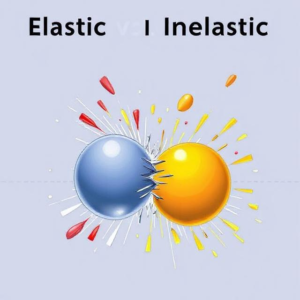Elastic and Inelastic Collisions
Collisions happen when two objects come into contact with each other, usually moving in different directions or at different speeds. The way these objects collide determines how energy is transferred between them. In physics, we generally classify collisions into two main types:

- Elastic Collisions
- Inelastic Collisions
1. Elastic Collisions
An elastic collision is a type of collision where both kinetic energy and momentum are conserved.
Key Features of Elastic Collisions:
- Momentum Conservation: The total momentum of the system (the objects involved in the collision) before the collision is equal to the total momentum after the collision.
- Kinetic Energy Conservation: The total kinetic energy (energy of motion) of the system before the collision is the same as after the collision. This means no energy is lost in the form of heat, sound, or deformation.
In simple terms: The objects bounce off each other without losing any energy.
Example of Elastic Collisions:
- Billiard Balls: When you hit a ball on a pool table with a cue ball, the balls bounce off each other. In this ideal situation, no energy is lost to heat or sound.
- Gas Molecules: The particles of a gas, like oxygen or nitrogen, move and collide with each other. In an ideal gas, these collisions are perfectly elastic, meaning no energy is lost.
Important Points:
- Elastic collisions mostly happen between objects that are hard and bouncy, like billiard balls or small gas particles.
- In real life, perfectly elastic collisions are very rare. However, some collisions (like between hard steel balls or gas molecules) can be approximated as elastic.
2. Inelastic Collisions
An inelastic collision is a collision where kinetic energy is not conserved, though momentum is still conserved. In other words, some of the kinetic energy is converted into other forms of energy, like heat, sound, or energy used to deform the objects.
Key Features of Inelastic Collisions:
- Momentum Conservation: Just like in elastic collisions, the total momentum of the system is conserved.
- Kinetic Energy Loss: The total kinetic energy is not the same before and after the collision. Some of it is transformed into heat, sound, or deformation energy.
In simple terms: The objects either stick together or bounce apart, losing some of their kinetic energy in the process.
Example of Inelastic Collisions:
- Car Crash: When two cars collide, they lose a lot of kinetic energy because it gets converted into heat, sound, and deformation (the crumple zones of the cars). This is an inelastic collision because kinetic energy is lost, even though momentum is conserved.
- Clay Balls: If you throw two clay balls at each other and they stick together upon collision, the energy used to deform them is no longer available for motion. This is an example of a perfectly inelastic collision (a special case of inelastic collisions).
Important Points:
- In inelastic collisions, the objects usually deform or generate sound and heat. For example, when a baseball hits a bat, some of the kinetic energy is turned into sound and heat.
- In perfectly inelastic collisions, the objects stick together after the collision. This is the maximum loss of kinetic energy because the objects move as a single mass after the impact.
3. Comparing Elastic and Inelastic Collisions
| Feature | Elastic Collision | Inelastic Collision |
|---|---|---|
| Kinetic Energy | Conserved (no energy loss) | Not conserved (some energy is lost) |
| Momentum | Conserved (before and after collision) | Conserved (before and after collision) |
| Example | Billiard balls, ideal gas particles | Car crashes, clay balls sticking together |
| Energy Loss | No energy loss (perfect bounce) | Energy lost as heat, sound, deformation |
| Objects After Collision | Bounce off each other | May bounce off, or stick together (perfectly inelastic) |
4. Special Case: Perfectly Inelastic Collisions
In a perfectly inelastic collision, the objects stick together after the collision, moving as a single mass. This is the extreme case of an inelastic collision where the maximum amount of kinetic energy is lost.
Example of Perfectly Inelastic Collision:
- Two Cars Colliding and Sticking Together: If two cars crash and stick together, they move as one unit after the crash. The kinetic energy is converted into internal energy (deformation of the cars) and sound energy.
Summary:
- Elastic Collisions: Momentum and kinetic energy are both conserved. The objects bounce off each other without losing energy to heat or deformation. Example: Billiard balls, ideal gases.
- Inelastic Collisions: Momentum is conserved, but kinetic energy is not. Some energy is lost as heat, sound, or deformation. Example: Car crashes, clay balls.
- Perfectly Inelastic Collisions: A special type of inelastic collision where the objects stick together after the collision, and the most kinetic energy is lost.
- Elastic collisions are idealized situations where objects bounce off each other without losing energy.
- Inelastic collisions are more common and involve the loss of some kinetic energy, which is converted into other forms of energy.
- In perfectly inelastic collisions, the objects stick together, and the kinetic energy loss is maximized.
Understanding the difference between elastic and inelastic collisions helps explain everything from the way gases behave to how cars crash or how everyday objects interact.
Tags: billiard balls, bouncing, car crash, clay balls, collision aftermath., collision behavior, collision examples, collision types, collisions, crumple zones, deformation, elastic collision properties, Elastic Collisions, energy conservation, energy dissipation, energy loss, energy transfer, Energy transformation, gas molecules, heat, impact, inelastic collision properties, inelastic collisions, kinetic energy conservation, kinetic energy loss, Mass, mechanical energy, Momentum, momentum conservation, momentum conservation law, particle collisions, perfectly inelastic collisions, physics, Sound, sticking together, Velocity


